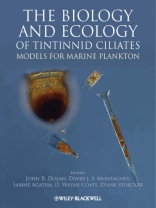Planktonic protists both produce and consume most of the primary production in the world ocean. They not only play key roles in the oceans but also represent an astounding amount of diversity: ecological morphological and genetic. However, for most taxa their ecology, morphology, phylogeny and biogeography are either poorly known or appear to be largely unrelated to one another; this hinders our understanding of their biology as well as interpretation of emerging genetic data. Tintinnid ciliates represent a singular exception. Compared to nearly all other groups of planktonic protists, there is a very substantial and relatively detailed literature (both modern and historical) on tintinnids. This volume synthesizes knowledge concerning a wide variety of topics ranging from anatomy and systematics, physiology, behavior, ecology (including ecological roles, predators, parasites, biogeography, and cysts) to fossil history. It will appeal to an audience ranging from advanced undergraduates to researchers in the fields of Oceanography, Marine Biology and Microbial Ecology.
Table of Content
CONTRIBUTORS viiCHAPTER 1 INTRODUCTION TO TINTINNIDS 1
1.1 Why a book on tintinnid ciliates? 2
1.2 What is a tintinnid ciliate? 3
1.3 The lorica as the defining characteristic of tintinnid ciliates 3
1.4 History of tintinnid studies 7
1.5 Tintinnids as model organisms for marine plankton 13
1.6 Key points 16
Acknowledgments 16
CHAPTER 2 THE TINTINNID LORICA 17
2.1 Introduction 18
2.2 Diversity formation and variability of loricae 19
2.3 Ultrastructure of loricae 32
2.4 Chemical composition of loricae 35
2.5 Lorica sedimentation 40
2.6 Key points 41
Acknowledgments 41
CHAPTER 3 SYSTEMATICS AND EVOLUTION OF TINTINNID CILIATES 42
3.1 Introduction 43
3.2 History of tintinnid taxonomy and systematics 44
3.3 Evolution of tintinnids 49
3.4 How to read the tintinnid cladogram 64
3.5 Molecular analysis and comparison with morphologic data 69
3.6 Systematics 75
3.7 Comparison with the evolution of related planktonic ciliates: the aloricate choreotrichids oligotrichids and halteriids 81
3.8 Key points 83
Acknowledgments 84
CHAPTER 4 ECOPHYSIOLOGY AND BEHAVIOR OF TINTINNIDS 85
4.1 Introduction 86
4.2 Feeding 86
4.3 Growth 99
4.4 Swimming behavior 106
4.5 Response to abiotic factors and interactions with biotic factors 111
4.6 Tintinnids as models and in models 114
4.7 Key points 121
Acknowledgments 121
CHAPTER 5 PREDATORS OF TINTINNIDS 122
5.1 Introduction 123
5.2 Predators of tintinnids 133
5.3 Anti-predator defenses of tintinnids 141
5.4 Top-down control of tintinnids 142
5.5 Importance of tintinnids as prey for the predator 143
5.6 Tintinnids as vectors for algal toxins 143
5.7 Key points 144
Acknowledgments 144
CHAPTER 6 PARASITES OF TINTINNIDS 145
6.1 Background 146
6.2 Dinoflagellate parasites: morphology and infection cycle 149
6.3 Molecular evolution of dinoflagellates parasitizing tintinnids 160
6.4 Ecology of tintinnid parasites 165
6.5 Summary and future directions 169
6.6 Key points 169
Acknowledgments 170
CHAPTER 7 COMPARATIVE BIOLOGY OF TINTINNID CYSTS 171
7.1 Introduction 172
7.2 Morphology 173
7.3 Encystment and excystment 176
7.4 Ecological function of cysts 182
7.5 Key points 184
Acknowledgments 185
CHAPTER 8 FOSSIL TINTINNIDS 186
8.1 Introduction: a paucity of data 187
8.2 Proterozoic tintinnids: no evidence of a beginning 187
8.3 Paleozoic tintinnid reports: too thin to know 191
8.4 Mesozoic tintinnids and calpionellids: same shape different composition 191
8.5 Cenozoic tintinnids: sparse 192
8.6 Organic and agglutinated phanerozoic fossils: the most likely candidates 193
8.7 Conclusions and perspectives 195
8.8 Key points 197
Acknowledgments 197
CHAPTER 9 TINTINNIDS IN MICROZOOPLANKTON COMMUNITIES 198
9.1 Ecology of microzooplankton 199
9.2 Quantitative importance of tintinnids in microzooplankton assemblages 205
9.3 Characteristics that set tintinnids apart from other microzooplankton 211
9.4 Key points 212
Acknowledgments 213
CHAPTER 10 DIVERSITY AND DISTRIBUTIONS OF TINTINNIDS 214
10.1 Introduction 215
10.2 Biogeography 215
10.3 Assemblages of coastal systems 233
10.4 Assemblages of open waters 239
10.5 Key points 241
Acknowledgments 243
REFERENCES 244
ORGANISM INDEX 288
SUBJECT INDEX 293
About the author
John Dolan style=’font-family:’>has worked on plankton ecology for over 25years in systems ranging from eutrophic estuaries to the
oligotrophic South Pacific. His research subjects are plankton
protists, especially ciliates and dinoflagellates and research
topics are biodiversity, species packing, and the relationships of
form and function.
David Montagnes style=’font-family:’>is an aquatic ecologist. He combines
modelling, laboratory, and field studies investigations into the
ecophysiology and behaviour of protists- aquatic taxa forming a
rich assemblage and occupying environmentally important niches. His
research themes include the flow of energy and biomass in
ecosystems and how abiotic and biotic properties and anthropogenic
perturbations alter individuals, populations, and
ecosystems.
Sabine Agatha style=’font-family:’>is a ciliate taxonomist. She has spent over 20
years describing and classifying ciliates mostly from marine
habitats by combining morphologic and genetic approaches. The
biodiversity, evolution, and biogeography of ciliates are her main
research topics.style=’font-family:’>
Wayne Coats style=’font-family:’>is a recently retired protistologist. His
research encompasses ecology, morphology, life history, and
taxonomy of dinoflagellates and ciliates. Parasitism and mixotrophy
are featured themes of his work.style=’font-family:’>
Diane Stoecker style=’font-family:’>is a biological oceanographer. Her laboratory
and field projects focus on microzooplankton and their grazing on
phytoplankton and role as prey for copepods and other
mesozooplankton. Plastid retention and mixotrophy in ciliates and
dinoflagellates and their effects on population dynamics and
trophic transfer are other favorite research topics.
Language English ● Format PDF ● Pages 304 ● ISBN 9781118358115 ● File size 33.1 MB ● Editor John R. Dolan & David J. S. Montagnes ● Publisher John Wiley & Sons ● Published 2012 ● Edition 1 ● Downloadable 24 months ● Currency EUR ● ID 2539131 ● Copy protection Adobe DRM
Requires a DRM capable ebook reader











![Cover of [加]史蒂文·厄尔: 地球气候简史 Cover of [加]史蒂文·厄尔: 地球气候简史](https://static.world-of-digitals.com/thumb_webp/226/9798869051226.webp)
